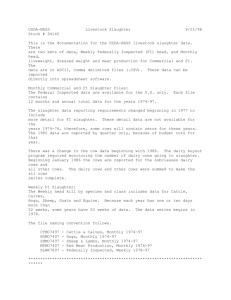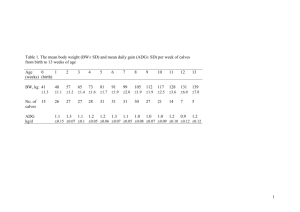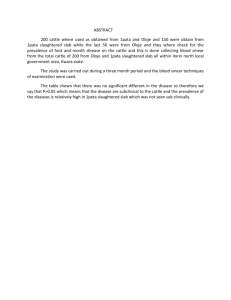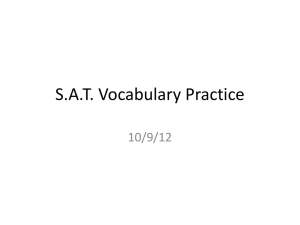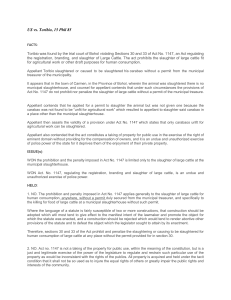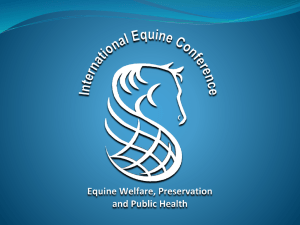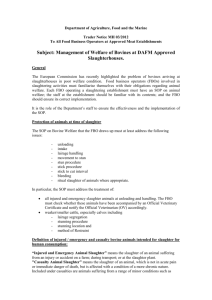Ethical Attitudes to Animals
advertisement
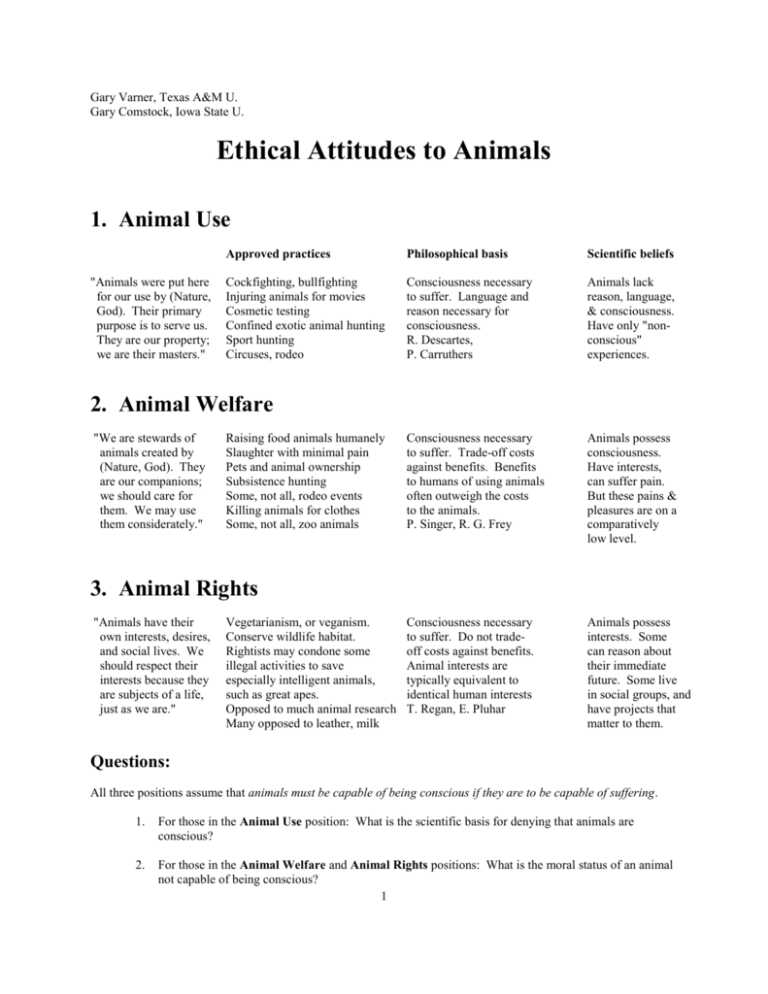
Gary Varner, Texas A&M U. Gary Comstock, Iowa State U. Ethical Attitudes to Animals 1. Animal Use "Animals were put here for our use by (Nature, God). Their primary purpose is to serve us. They are our property; we are their masters." Approved practices Philosophical basis Scientific beliefs Cockfighting, bullfighting Injuring animals for movies Cosmetic testing Confined exotic animal hunting Sport hunting Circuses, rodeo Consciousness necessary to suffer. Language and reason necessary for consciousness. R. Descartes, P. Carruthers Animals lack reason, language, & consciousness. Have only "nonconscious" experiences. Consciousness necessary to suffer. Trade-off costs against benefits. Benefits to humans of using animals often outweigh the costs to the animals. P. Singer, R. G. Frey Animals possess consciousness. Have interests, can suffer pain. But these pains & pleasures are on a comparatively low level. Consciousness necessary to suffer. Do not tradeoff costs against benefits. Animal interests are typically equivalent to identical human interests T. Regan, E. Pluhar Animals possess interests. Some can reason about their immediate future. Some live in social groups, and have projects that matter to them. 2. Animal Welfare "We are stewards of animals created by (Nature, God). They are our companions; we should care for them. We may use them considerately." Raising food animals humanely Slaughter with minimal pain Pets and animal ownership Subsistence hunting Some, not all, rodeo events Killing animals for clothes Some, not all, zoo animals 3. Animal Rights "Animals have their own interests, desires, and social lives. We should respect their interests because they are subjects of a life, just as we are." Vegetarianism, or veganism. Conserve wildlife habitat. Rightists may condone some illegal activities to save especially intelligent animals, such as great apes. Opposed to much animal research Many opposed to leather, milk Questions: All three positions assume that animals must be capable of being conscious if they are to be capable of suffering. 1. For those in the Animal Use position: What is the scientific basis for denying that animals are conscious? 2. For those in the Animal Welfare and Animal Rights positions: What is the moral status of an animal not capable of being conscious? 1 Three case studies in animal agriculture 1. Beef slaughter Approximately 30 million cattle are slaughtered yearly in the United States. When it comes to.the slaughter procedure itself, the large-scale, state-of-the-art facilities capable of slaughtering as many as 400 or 600 animals per hour are, perhaps contrary to popular belief, the most humane. The races approaching the stunning chute can be designed to look just like those through which cattle have traveled previously for routine veterinary care, experienced handlers can move animals along without prodding, cattle do not "smell blood in the chutes," and "stunning" is a misnomer for what happens in the kill chute, since a properly placed shot with a "stun gun" obliterates the animal's brain, making it impossible to regain consciousness. Question: Should this method of slaughter be legally required? Use the form on the next page to answer the question from the perspective of three different theoretical positions in animal ethics. 2. Milk cows On average, milking cows spend between three and four years in production, after which they are slaughtered for relatively low-grade beef. Dairy farmers maintain high productivity by breeding cows to calve about yearly. The calves are removed from their mothers immediately or within days, with most of the female calves becoming replacement milk cows and almost all of the male calves being raised for veal. Statistics indicate that about one seventh of the cattle slaughtered yearly are from dairy herds. Question: Is this method of milking morally permissible? Use the form on the next page to answer the question from the perspective of three different theoretical positions in animal ethics. 3. Laying hens Today over 90% of laying hens in the United States live caged in intensive egg production facilities, which have increased the average yield per hen from 70 in 1933 to 275 today. In these facilities, birds cannot forage, flap their wings, dust-bathe, nest, establish dominance hierarchies, or even preen themselves in natural ways; culling of injured birds is economically inefficient, and the entire population of a battery operation is slaughtered and replaced periodically (every 12-15 months on state of the art operations). Poultry are still exempt from federal humane slaughter legislation and by comparison to state of the art cattle slaughter facilities, poultry slaughter is still a relatively indelicate affair; fully conscious birds are hung from their legs on conveyor belts before being stunned and beheaded. Question: Is this method of obtaining eggs morally permissible? Use the form on the next page to answer the question from the perspective of three different theoretical positions in animal ethics. Reference and acknowledgement Gary Comstock prepared the first draft of the chart, basing it on an online lecture by Gary Varner of the Philosophy Department, Texas A & M University, “Lecture on animal rights and animal welfare.” Varner wrote the three cases, which appeared originally in The Ag Bioethics Forum 8 (December 1996): 4, 6, 9. They are based on information in Bernard Rollin's Farm Animal Welfare: Social, Bioethical, and Research Issues (Iowa State University Press, 1995), and in Gary E. Varner, "What's Wrong with Animal By-Products?" Journal of Agricultural and Environmental Ethics 7 (1994): 7-17. Comstock devised the student exercise on p. 3. 2 Three case studies in animal agriculture Explain how each ethical theory assesses each way of treating animals . 1. On each line, write "J," "NJ," or "D" J = Ethically justified NJ = Not ethically justified D = Depends 2. In complete sentences, explain each of your answers. Beef slaughter Milk cows Laying hens Animal use : ___________ ___________ _________ Animal welfare : ___________ ___________ __________ Animal rights : ___________ ____________ ____________ 3
